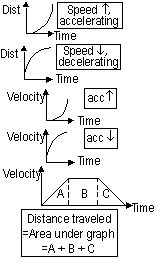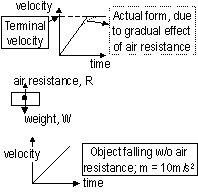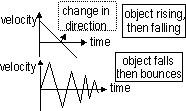Phys1
MEASUREMENTS IN PHYSICS
Measurement of mass and weight
mass-amount of matter in a body (constant), S.I. unit-kg, measured by beam/lever balance
mass is also a measure of the inertia of a body, the tendency of a body to remain in its existing state of motion; greater mass, greater inertia
weight- force exerted by gravitational pull of earth (varies), S.I. unit newton (N), measured by spring balance
weight = mass x acceleration due to gravity (mg)
Density = mass/volume, unit = g/cm3 or kg/m3

Speed, Velocity and Acceleration
Speed-dist travelled per unit time [total dist(m)/total time(s)], m/s, scalar
Displacement-dist travelled in a specific direction
Velocity-dist travelled per unit time in a specific direction, [displacement(m)/time(s)], S.I. unit = m/s, vector quantity (magnitude + direction) [velocity = speed + direction]
Acceleration-rate of change of velocity, vector =change in velocity/time = (Final velocity-initial velocity)/time = (v-u)/t
S.I. unit = m/s2, + acc. = accelerating, increasing velocity, - acc. = decelerating, retarding, decreasing velocity
acc due to gravity- constant acc all free falling objects fall under due to force of gravity, if air resistance is negligible, denoted as 'g' (9.8m/s) [falling objects +ve or rising objects -ve]

s = ut + ½at2 s = dist, u = initial velocity, t = time, a = acceleration
An experiment to measure 'g'

switch: A > B, clock start, ball drops > trap door opens clock stops
s = ut + ½at2
d = 0 + ½gt2
g = 2d/t2
terminal velocity- constant velocity of falling objects when air resistance = weight of object (resultant force = 0)


Forces
Energy
Pressure
Light
Magnetism
Electrostatic Charging
Electricity
Thermal Physics
Waves & Sound
Radioactivity
Back to 'O' level notes index
Back to notes index




